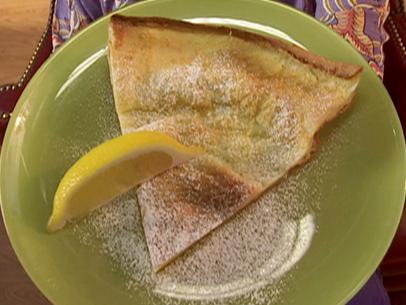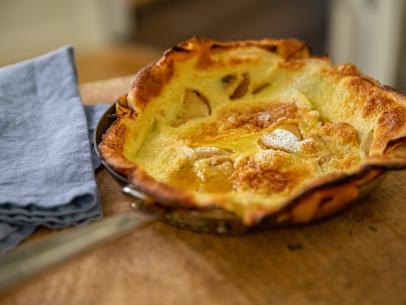
Dutch Baby
- Level: Easy
- Total: 40 min
- Active: 10 min
- Yield: 2 to 4 servings
-
- Nutritional Analysis
- Per Serving
- Serving Size
- 1 of 4 servings
- Calories
- 178
- Total Fat
- 7 g
- Saturated Fat
- 3 g
- Carbohydrates
- 22 g
- Dietary Fiber
- 1 g
- Sugar
- 6 g
- Protein
- 7 g
- Cholesterol
- 105 mg
- Sodium
- 219 mg
- Level: Easy
- Total: 40 min
- Active: 10 min
- Yield: 2 to 4 servings
-
- Nutritional Analysis
- Per Serving
- Serving Size
- 1 of 4 servings
- Calories
- 178
- Total Fat
- 7 g
- Saturated Fat
- 3 g
- Carbohydrates
- 22 g
- Dietary Fiber
- 1 g
- Sugar
- 6 g
- Protein
- 7 g
- Cholesterol
- 105 mg
- Sodium
- 219 mg
Ingredients
Directions
- Preheat the oven to 425˚ F. Heat the milk in the microwave or in a small saucepan until warm. Pour the warm milk into a large bowl and add the eggs, granulated sugar and salt. Whisk until well combined, then add the flour and whisk until the batter is mostly smooth (a few small lumps are OK). Let stand 5 to 10 minutes, then whisk until airy and very smooth; you should see small bubbles on the surface of the batter. (You can also puree the mixture in a blender.)
- Meanwhile, put a 10-inch ovenproof skillet in the hot oven and heat for 10 to 15 minutes. Add the butter to the skillet in the oven and heat until the butter melts and the bubbles subside (do not let the butter brown). Pour the batter into the skillet.
- Bake until the pancake rises in a cup shape and is browned around the edges on top and lightly browned on the bottom, 15 to 20 minutes. Reduce the oven temperature to 325˚ F and continue baking until the bottom is browned and mostly dry, 5 to 10 more minutes.
- Dust the pancake with confectioners' sugar and serve immediately.
Cook’s Note
To get those crispy edges, preheat your skillet for at least 10 minutes so the batter starts cooking on contact. A touch of sugar in the batter helps, too. A Dutch baby puffs up in the oven and deflates soon after you take it out. To keep it from collapsing too much, lower the oven temperature toward the end of the cooking time — this will allow the pancake to cool slowly and gently. There’s no wrong way to top a Dutch baby. Serve it straight from the skillet with just confectioners' sugar or maple syrup, or try berries or jam. You can also go the savory route and top it with sliced ham and fried eggs. A cast-iron pan works best because it gets super hot — which makes for a bigger and better puff! If you’re not serving the Dutch baby right away, slide it out of the skillet and onto a rack so it won’t get soggy.
Looking for Something Else?
Related Pages
- Sausage-and-Mushroom Dutch Baby Recipe
- Garlic-Rosemary Dutch Baby Recipe
- Rachael Ray's Stuffed Baby Bellas Recipe
- Cherry Almond Dutch Baby Recipe
- Grilled Soy, Ginger and Lime Tofu Steaks with...
- Mushroom Dutch Baby with Chorizo Potatoes Recipe
- Bacon Cornbread Dutch Baby Recipe
- Hoisin and Sriracha–Glazed Baby Back Ribs Recipe
- Savory Dutch Baby Recipe

































